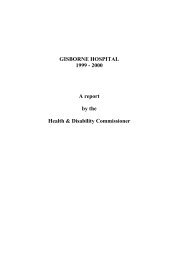09HDC01565 - Health and Disability Commissioner
09HDC01565 - Health and Disability Commissioner
09HDC01565 - Health and Disability Commissioner
You also want an ePaper? Increase the reach of your titles
YUMPU automatically turns print PDFs into web optimized ePapers that Google loves.
<strong>Health</strong> <strong>and</strong> <strong>Disability</strong> <strong>Commissioner</strong><br />
INFORMED CONSENT<br />
On the information available I am satisfied that informed consent was obtained from<br />
an adult male competent patient prior to surgery being consistent with the principles<br />
stated in the Code of <strong>Health</strong> <strong>and</strong> <strong>Disability</strong> Services Consumers‘ Rights document.<br />
I am of the view that proper <strong>and</strong> adequate information was conveyed to the patient<br />
being a reasonable person capable of making a reasonably informed decision<br />
regarding the undergoing of the recommended procedure.<br />
I believe that ―material‖ risks of the proposed procedure were stated <strong>and</strong> that the<br />
patient‘s temperament, health, personality <strong>and</strong> level of underst<strong>and</strong>ing were considered<br />
in the consenting process which I believe was valid.<br />
There is a possibility of a fatal complication occurring following any neurosurgical<br />
procedure of the magnitude suggested to the patient in this instance, however in<br />
consideration of an acceptable low risk provision of detailed information regarding<br />
such a possibility is not, in my opinion, essential to the consenting process <strong>and</strong> could<br />
in an anxious <strong>and</strong> apprehensive patient lead to a decision not to undergo surgery <strong>and</strong><br />
to the patient‘s detriment.<br />
SURGICAL PROCEDURE<br />
The documentation indicates that an appropriate procedure was performed in a<br />
technically sound manner by a senior neurosurgical registrar trainee under direct<br />
supervision of the responsible surgeon. The st<strong>and</strong>ard of treatment in this regard could<br />
not be questioned <strong>and</strong> this is supported by the absence of any post mortem finding<br />
indicating a direct surgical complication such as haemorrhage, brain swelling,<br />
infarction or direct injury to neural structures.<br />
POST OPERATIVE CARE — ANALGESIA/OBSERVATIONS<br />
The use of patient controlled analgesia is an accepted technique for patients<br />
undergoing surgical treatment as employed in this case. The opiate Morphine was<br />
administered in a st<strong>and</strong>ard dose <strong>and</strong> the total dose administered was well within<br />
accepted levels, <strong>and</strong> in the hours prior to the patient‘s death use was limited, …<br />
[comments deleted as not relevant to the advice sought].<br />
Notwithst<strong>and</strong>ing the above comments monitoring of patients using PCA is essential in<br />
detection of adverse reactions or dose excess with consequences particularly<br />
respiratory depression <strong>and</strong> altered conscious state. It is currently recommended that<br />
observation of both respiration <strong>and</strong> arousal level be used in combination for purposes<br />
of monitoring, <strong>and</strong> in this instance it is apparent that the former was not the subject of<br />
specific observation <strong>and</strong> recording <strong>and</strong> this may have contributed to an unawareness<br />
of deterioration in respiratory function albeit unrelated to the PCA technique.<br />
With respect to the recording of patient arousal levels I would express surprise that<br />
with the protocol used, the sedation score recording of level 4 (normally sleepy, easy<br />
to rouse) did not require specific response, but the lower recording of 3 (somnolent,<br />
5 September 2012 50<br />
Names have been removed (except Canterbury DHB <strong>and</strong> the experts who advised on this case) to<br />
protect privacy. Identifying letters are assigned in alphabetical order <strong>and</strong> bear no relationship to the<br />
person’s actual name.
















